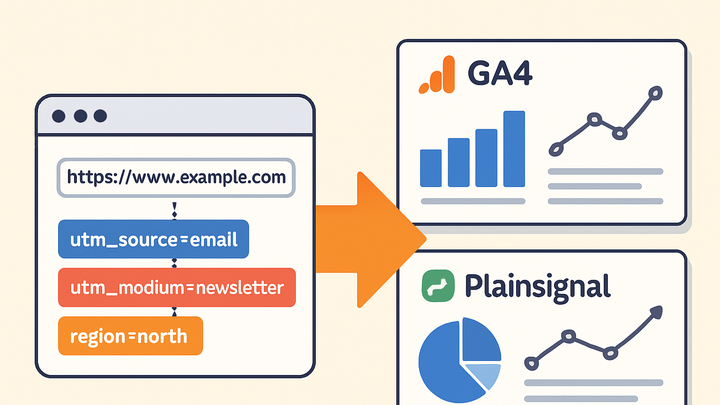Published on 2025-06-22T06:54:15Z
What is a Campaign Code? Examples for Campaign Codes
Campaign codes are unique identifiers appended to URLs or embedded within tracking scripts to attribute user actions to specific marketing campaigns. They allow analytics platforms like GA4 and PlainSignal to distinguish traffic sources, measure the effectiveness of email, social, and paid campaigns, and calculate key metrics such as click-through rates and conversions. In GA4, campaign codes typically use UTM parameters, while PlainSignal supports custom data attributes in its cookie-free tracking snippet. Implementing consistent naming conventions and including source, medium, and campaign parameters ensures accurate attribution and comparable data across channels. Proper use of campaign codes empowers marketers to optimize strategies, allocate budgets effectively, and demonstrate ROI.
Campaign code
Unique identifiers appended to URLs or scripts to tag marketing campaigns for accurate attribution in analytics platforms.
Definition and Purpose
Campaign codes are labels used to identify specific marketing campaigns within analytics platforms, enabling precise attribution of user interactions.
They serve to distinguish between different channels, mediums, and campaign strategies, allowing marketers to measure performance and optimize efforts effectively.
-
Definition
A campaign code is a unique identifier appended to a URL or embedded in a tracking script that marks traffic from a specific marketing campaign.
-
Purpose
They help analytics tools like GA4 and PlainSignal attribute sessions, clicks, and conversions to the correct campaign source, medium, or creative variation.
Implementing Campaign Codes
Campaign codes can be implemented in various analytics platforms through URL parameters or custom script attributes. Below are examples for GA4 and PlainSignal.
-
GA4 implementation (utm parameters)
In GA4, campaign codes are passed via UTM parameters appended to URLs. GA4 automatically captures utm_source, utm_medium, utm_campaign, and more when users click tagged links.
-
Example utm url
https://example.com/?utm_source=newsletter&utm_medium=email&utm_campaign=spring_sale -
Configuration in GA4
GA4 requires no additional setup beyond adding UTM parameters; view reports under Acquisition > Traffic Acquisition.
-
-
PlainSignal implementation
PlainSignal uses a cookie-free tracking script. You can include campaign codes via custom data attributes in the tracking snippet to tag sessions with your campaign identifier.
-
Example tracking snippet
<link rel="preconnect" href="//eu.plainsignal.com/" crossorigin /> <script defer data-do="yourwebsitedomain.com" data-id="0GQV1xmtzQQ" data-api="//eu.plainsignal.com" data-campaign="spring_sale" src="//cdn.plainsignal.com/plainsignal-min.js"></script> -
Adding campaign code
Append a
data-campaign="spring_sale"attribute to the script tag to tag all subsequent pageviews with that campaign code.
-
Best Practices
Following best practices ensures clean, consistent, and actionable campaign data across all reporting tools.
-
Naming conventions
Use lowercase letters, hyphens instead of spaces, and clear descriptors that reflect campaign details (e.g.,
spring-sale-email). -
Consistent parameter use
Always include source, medium, and campaign parameters or attributes to avoid gaps in reporting.
-
Centralized documentation
Maintain a shared campaign code repository (e.g., a spreadsheet or tagging plan) to align all stakeholders on naming conventions.
Troubleshooting Common Pitfalls
Common issues can compromise data quality; knowing how to troubleshoot them helps maintain reliable analytics.
-
Missing or incorrect parameters
Omitting
utm_sourceordata-campaigncan lead to untagged traffic, which GA4 marks as ‘direct’. Always validate that parameters are present and spelled correctly. -
Inconsistent naming
Variations in campaign code spelling or casing fragment data. Stick to a standardized format to consolidate reports.
-
Parameter order irrelevance
UTM parameter order in the URL does not affect tracking, but inconsistent parameter inclusion does. Ensure completeness rather than order.
